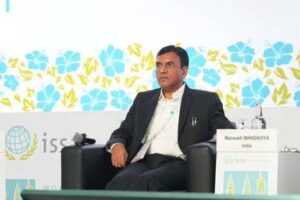Digital News Guru National desk:
India’s Social Security Surge: From 19% to 64.3% in Ten Years — A Breakthrough in Welfare
India has achieved a remarkable milestone in social protection: its social security coverage has risen from 19% in 2015 to 64.3% in 2025, according to the latest data from the International Labour Organization (ILO). This leap has brought nearly 940 million people—or about 94 crore citizens—under at least one form of social security benefit.
What’s Behind the Numbers
Defining Social Security Coverage
In this context, “social security coverage” refers to people who receive at least one legislatively-backed, cash-based or in-kind social protection benefit, such as pensions, maternity benefits, child support, or welfare schemes. The ILO’s criteria require that the scheme be legally backed, active, and have verified data over several years.

Data Sources & the Data Pooling Exercise
The figures are drawn from Phase I of India’s Social Protection Data Pooling Exercise, conducted in collaboration with the ILO. This initial phase covers central government schemes and women-centric schemes in eight states.
As more schemes and states are incorporated in Phase II and beyond, the government is confident that the coverage will climb even higher and may cross 100 crore (1 billion) once all data verifications are complete.
Recognition: The ISSA Award 2025
Adding to these achievements, India has been awarded the ISSA Award 2025 (International Social Security Association) for “Outstanding Achievement in Social Security.”
This award, given every three years at the World Social Security Forum (WSSF), recognizes countries that show exceptional progress in expanding social protection and improving access for vulnerable populations.
Labour and Employment Minister Mansukh Mandaviya accepted the award on behalf of the government. In his remarks, he credited India’s trajectory to policy reforms, digital innovation, better data systems, and the government’s welfare-focused programs.
The Role of Government Policies & Programs
Several policies and reforms have played key roles in this expansion:
- Welfare & Benefit Schemes: Schemes like PM-KISAN (income support for farmers), Janani Suraksha Yojana (maternal support), PM POSHAN (mid-day meal scheme), and old-age pension schemes have helped widen the safety net.
- Women-Centric Programs: Special attention to schemes benefiting women has been part of the first phase of data pooling, helping ensure that gender gaps in access are addressed.
- Digital & Data Reforms: The national data pooling initiative helps consolidate beneficiary data from multiple schemes and states, improving transparency and reducing overlap or exclusion. Use of identity tools (like Aadhaar) and digital delivery have helped streamline distribution.
- Legislative Backing: Only those schemes that are legislatively grounded and active, with verified data, are counted. This ensures legitimacy and sustainability.

Why It Matters
- Massive Social Impact
Bringing nearly 94-100 crore people under at least one form of protection means that many more citizens have safeguards against shocks—like illness, old age, or job loss—and access to essential services. It is a buffer against poverty and vulnerability. - Global Positioning
India now ranks second in the world by number of beneficiaries under social protection. This strengthens its voice in international forums and enhances credibility in negotiations involving labour, welfare, and migration. - Policy & Governance Validation
Recognition by ILO and ISSA provides external validation of India’s welfare policy direction. It underscores how data systems, welfare architecture, and program implementation are yielding measurable results. - Momentum & Future Potential
Since the current data only covers Phase I, with Phase II addition, more central and state schemes, more beneficiary categories, and more regions, there is high scope for further increase. Crossing 100 crore beneficiaries seems within reach.
Challenges & What to Watch
While the progress is impressive, several challenges remain:
- Depth vs Breadth: Having “at least one” benefit may not be enough. Many people need multiple protections — health, income support, old age pensions, etc. Measuring the adequacy and quality of benefits will be important.
- Data Gaps & State Disparities: The first phase covers only some states and some schemes. Some poorer or remote regions may still lag behind in both access and beneficiary data. Ensuring uniform rollout is crucial.
- Sustainability: Such large welfare systems require finance, administrative capacity, and oversight. Ensuring schemes are not underfunded, dysfunctional, or subject to leakages is vital.
- Inclusion of Informal Sector Workers: A large part of India’s workforce is in the informal sector, often without traditional employer-based protections. Ensuring they benefit in meaningful ways remains a challenge.
- Public Awareness: Many eligible beneficiaries may still be unaware of entitlements, or may face barriers (documentation, accessibility, awareness). Bridging these gaps is essential.

Looking Ahead
Going forward, India’s priorities could include:
- Expanding Phase II of the data pooling: bringing in more states, more welfare schemes, and especially strengthening verification practices.
- Ensuring schemes are equitable, especially for marginalized communities (women, rural populations, informal workers, minorities).
- Focusing on benefit adequacy — not only reaching people, but ensuring the support is sufficient to make a meaningful difference.
- Strengthening financial sustainability, oversight, and transparency to reduce fraud or misuse.
- Deepening international cooperation, for example through Social Security Agreements (SSAs) with other nations, portability of benefits, and mutual recognition frameworks.
Conclusion
India’s rapid expansion of social security coverage from 19% in 2015 to about 64.3% in 2025 represents one of the most significant social protection gains in recent years. Recognition through awards such as the ISSA Award 2025 underscores that this is not just a matter of numbers, but a signal of institutional commitment, policy reform, and transformative welfare infrastructure.
While challenges remain, the progress so far provides a solid foundation. As India proceeds with further phases of coverage, deeper inclusion, and more robust benefit design, the country could set new benchmarks for social protection globally. This is more than growth in statistics—it’s an evolving safety net for millions, a promise of inclusion, and a test of governance in its truest sense.
You May Also Read: Bareilly Internet Suspended for 48 Hours as Tensions Flare Ahead of Juma








